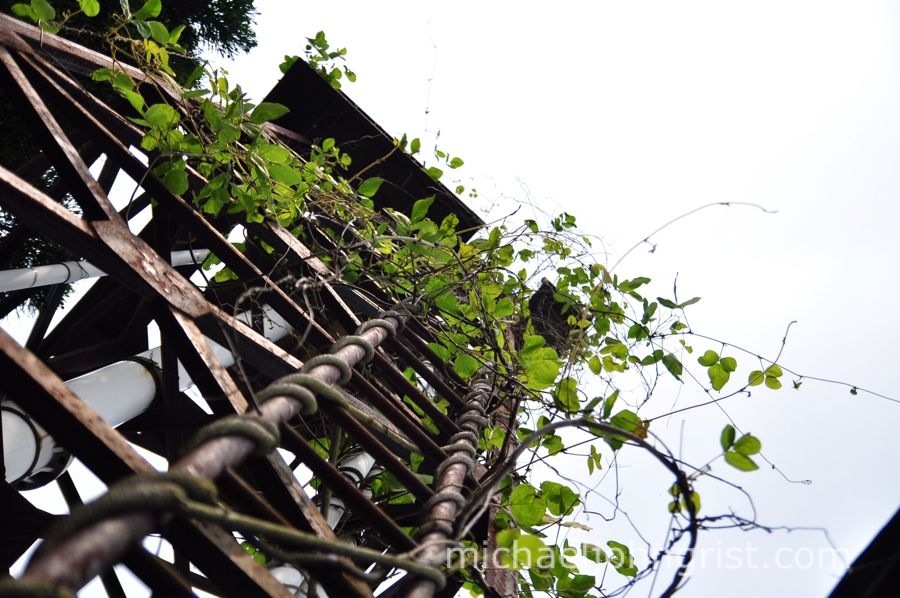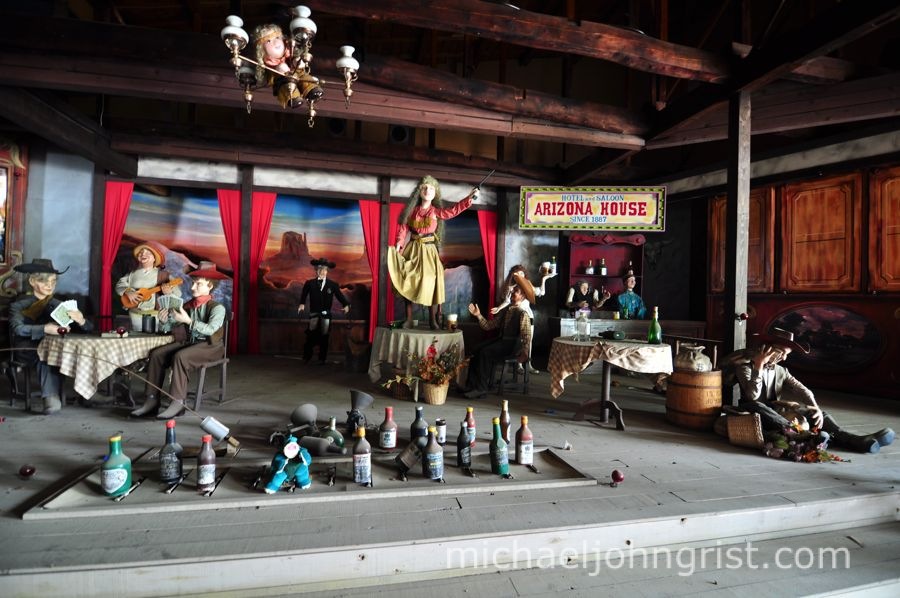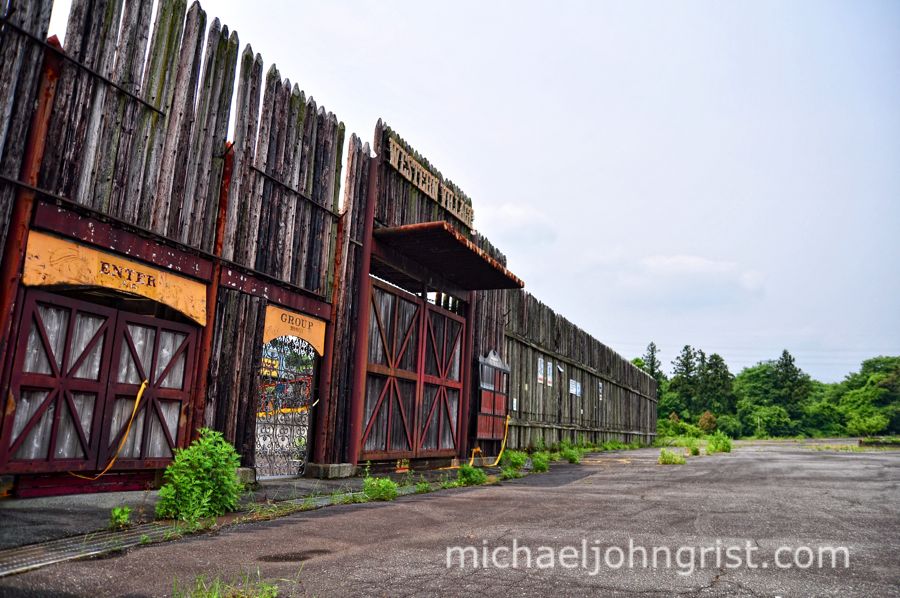Western Village is a quantum pocket of the Old West Disneyfied and transplanted wholesale from the American collective unconscious, replete with a $29 million replica Mount Rushmore, Western saloon, ghost house, jail, post office, shooting gallery, actual fake Rio Grande, and vast Mexican barrens.
It was built in 1975 and shut down in 2007, likely due to its remote location and the pull of other nearby parks like Disneyland sucking away its tourist base.
Now it’s a ruin, or haikyo, open only to urban explorers willing to take their chances clambering over the stockade wall.
The car park outside the Village stockade.
Mid-shootout, bleeding rust.

Kerchiefed cowboys driving a wagon across the car park plain.

Sturdy, tall, tough to climb stockade.
High noon (with washed out Japanese spring skies).
You burst through the Old West town’s 3-meter tall Indian stockade, six-irons ready for a shoot-out, but the place is silent. Long deserted boulevards stretch before you, weeds growing up through the dust. Only a rag-haired ostler at the lonely stagecoach station gazes back at you with a vapid Colorado stare, his vacuum-tube heart bared for all to see.
Your spirits sink. This place is not what it once was. A roll of tumbleweed gusts along the dry and dusty street.
Welcome to the Western Village.

The central saloon.

Overgrown cowboy facade.

Catch a stagecoach to Utah.

Armory / gunsmith.

Possibly the sherriff’s office.

From a tarpaper rooftop, like a Clayton sharpshooting sniper.

Buffalo stampede.

Spirits, candy floss, hot dogs by the church.

Nasty looking scar. Doubtless you could get WANTED posters made of you in the park.
Early History
Western Village started life humbly in 1970 as the ‘Kinugawa ranch’ in the Japanese countryside, a 4-acre family owned camp where folks could come for horse-riding, lasso practise, and go fishing in the fish pond (not exactly cowboy, I know). As time went by and the green rolled in, owner Kenichi Ominami’s ambitions grew.
He expanded what began as a simple wooden complex to become a USJ-like cowboy town, all wooden facades, horses, and dusty thoroughfares, as though you’d stepped onto the set of a John Ford Western.

The Family Ranch summer camp in 1979.
Glory days.
In time Ominami hired wranglers and cowboys for shows he put on 4 times a day, just like the parades of Disneyland but instead of Mickey and Minnie singing A Whole New World with giant floats of Robin William’s blue genie floating overhead, there was a story of cowboy lust, violence, and revenge.
You sat in the bleacher stands watching the center of town- of course the saloon- as gun battles played out before you, men went down, horses cantered past. At times there were displays of gunmanship and skill, with hired men shooting the apple off unwitting guests’ heads, William Tell style.
If you were lucky you might catch a glimpse of Ominami himself striding the boardwalk like a rootin-tootin pistoleer, clad in ten-gallon hat, leather chaps, and spurs.

The Western Village’s cowboy tale- from here.
1- The Sheriff hears about the Rogue gang.
2- ‘Crutches’ talks smack about the Sheriff who crippled him, to guests pulled out of the 20-strong audience.
3- More guests pulled onto the stage and put into the story.
4- Sheriff starts to lay down the law.

1- Sheriff shoots balloons using a hand-mirror.
2- Taking aim at an apple on a guest’s head.
3- Bam!
4- Apple into dust. Amazing. Incredibly dangerous?

1- Another occasion, horse work.
2- Sheriff posing on the deck while the crowds watch.
3- Impressive fire finale.
Wild Expansion
And things expanded further, as guest numbers rose to near 1 million per year. In 1995 Ominami, then 52, took a trip to the land of his imagination, after seeing Kevin Costner’s frontier movie “Dances With Wolves.” In South Dakota he was flabbergasted by the sheer epic scale of the cowboy landscape- so different from the renderings he’d grown up watching on Rawhide as a child.
He wanted to bring a taste of that scale to Japan, to share that sense of sweeping red desert and lonesome blue skies with a people who had only ever seen it in black and white at 12 inches across.
So he started down an interesting road- the path to building a clone of Mt. Rushmore at one third scale. I’ll talk about that more in a later post. He also expanded across a small stream that cut across his land, labelling it the Rio Grande and everything ‘south’ of it as Mexico Land.

Ominami in front of his replica Mt. Rushmore.
Cantering towards bankruptcy.
As his cowboy dreamland grew, so did its debts. Fewer and fewer people were making the long and arduous voyage to his camp, resulting in increasing pressure from the banks to cash in somehow and get back a fraction of the millions they had invested.
In 2007 the dream fell flat. From a few bits of financial reporting scattered across the web I gleaned that the closing was only meant to be temporary, for maintenance lasting just a few months. The cowboys would return from their sojourn in the desert soon, and all would be as it was; bean cans roasting on the open fire, buffalo haunches glazed with wild honey, shootouts and harlots and horse-riding galore.
But that didn’t happen, or hasn’t happened yet. Is it because of Ominami? He’d be around 78 now and perhaps unwell, if not passed away. If he is dead, would anyone really want to take on his park, which could not have been making good returns?
I doubt it. I doubt his park ever paid off the debts it incurred in 1995 for Mount Rushmore, looking at photos from recent years showing the stands sparse of punters, and reading reports about how it felt abandoned even while under operation. I doubt it ever would pay off those debts, unless vast new investment were to transform it from what it is now to something able to compete with Disney, and even then it would only have more debt to earn back- which I doubt it could. Who would want to take that on?

Empty park. A latter-day anachronistic addition (what was wrong with horses?)- Segway riding.

Hottie cowgirl doing promo.
Promo video of the Western Village.
Ominami’s park was perhaps never fated to generate profits. It was a realization of a dream, built by a man who cared more about the dream than the business. He even said as much in a 1995 interview-
“I’m an example of a self-made man,” said Ominami. “The goal of life is not to make money, but to make your dreams come true.”
Now his dream stands derelict and empty, a slowly fading museum to a time long gone, in a country far away. It’s always possible it may reopen some time in the future, but more likely is a fire-sale of its assets, the destruction of Mt. Rushmore, and an ignominious end in the imagination of the people who lived nearby- the few people likely to remember it ever existed.
Taming the West
Maybe that’s fitting. The West was won, one way or the other. One-horse towns like the Cowboy Park have little hope of competing against globalized, multinational corporations like Disney and Universal Studios. The railroads came in, ushered out the little big men in their warrens of minor power, and transformed the world to something bigger, broader, and wider than it was before.
However, we’re not done with Japan’s Wild West yet. There’s still the story of my explore, the story of Mt. Rushmore, the story of cowboy-fascination in Japan, and all the photos of the cowboy ghost-houses, John Wayne, Clint Eastwood, and so on.
In the meantime, a video of the main walkthrough.
Then more to come:

Explore!

Into the saloon.

Climbing.

Animatronics galore!
Western Village series:
Explore more Japanese ruins (haikyo) in the galleries:
[album id=4 template=compact]See a curation of world ruins in the ruins gallery.
You can also read my SF & Fantasy stories inspired by ruins here.


